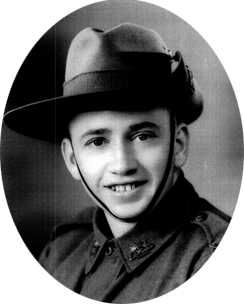Douglas Errol Bagshaw
Rank: Private
Service Number: SX7468
Units Served: 2/48th Battalion
Personal Details: Douglas Errol Bagshaw was born on the 11th of January 1919 at Clarendon, South Australia. He had a fair complexion, blue eyes and brown hair. Douglas was the fifth child of seven to John Edward Stokes and Bessie Clarice Symons with which he lived in the family home at Mclaren Flat. He was single at time of enlistment and worked as a labourer prior the war. He classified himself as a Methodist.
Enlistment Details: He enlisted on the 2nd of July 1940 in Adelaide and was posted to the 2nd Reinforcement of the 48th Battalion as a private at the age of 21.
Details about his role in War: After he enlisted and was placed in the 2/48th Battalion, his battalion spent a further five or so months in Adelaide, while attempting to rein in more recruits, as well as sufficient training in preparation for departure. On the 21st of November his unit sailed to Fremantle on the HMT Stratheden and departed Australia on the 28th. On the 15th of December the convoy entered and anchored in the Gulf of Suez and the unit disembarked to journey to their camp near Gaza. The Battalion continued normal routines while in Palestine. Christmas day was celebrated with a service on an old A.I.F.’s battlegrounds, where Christmas carols were sung and soldiers awed at their first Christmas in the land of Christ’s birth.
On the 11th of January 1941, the Battalion marched towards the Mediterranean Sea, during which they followed a route, used tactical formations with scouts, and made sure to seek cover when resting. It was the Battalion’s first experience of warfare tactics outside of training. On the 5th of February, the Battalion joined other units to perform a divisional parade for Prime Minister Menzies and Lieutenant-General Blamey.
On the 11th of March, the Battalion was finally given orders to leave Palestine and moved past Alexandria, to Mersa Matruh, near the Libyan border, while on the way, meeting some colourful local characters (Egyptian Magicians) and experiencing a horrendous dust storm. The Battalion set up camp at Sidi Barrani, some 200 kilometres from the Libyan border. On the 18th of March the unit set up camp in Ain El Gazala, this journey involved traveling through Tobruk, which displayed many captured war material on the sides of the road, giving the soldiers a defined sense of victory. When they arrived an officer reported the surprise the troops got ‘…to find a place quite so barren, desolate and uninviting...’ The Battalion later reached Baracca via Ain El Gazala on the 2nd of April. On the 7th of April, the Battalion became the first South Australian battalion to engage with enemy forces, despite it being the last to be formed. This interaction was in the form of a casualty gaining a clean flesh wound from the enemy. From this point onwards, the Battalion became actively involved in the war. Much of their time was spent shifting between Benghazi and Derna, and Tobruk.
In early April, the Battalion was ordered to advance and retreat repeatedly. During this period of retreat, the hardships they faced including lack of supplies and equipment and horrendous weather conditions could not destroy the high morale of the troops; they just wanted their chance to fight. Their desire was not fulfilled, though the enemy teased numerous times, until the 9th of April, on which date they were ordered to take up position in the defences of Tobruk. On the 11th of April, the entire Battalion arrived to relieve the 2/28th Battalion, and so, the 2/48th Battalion finally began its notorious role, as defenders of Tobruk alongside the 2/24th and the 2/17th. Throughout the rest of April, Douglas’ Battalion continued to block many enemy attacks on the fortress, on one occasion, capturing 803 prisoners. On the 17th of April, the persistent enemy sent in tanks that almost reached the Battalion’s reserve company, though lack of infantry troops prevented a victory, the persistent enemy positioned themselves just outside the wire. Douglas was killed in action during a somewhat counterattack on the 1st of May 1941, he was among 51 casualties of that attack.
Age at Death: 22
Cemetery or Memorial Details: Knightsbridge War Cemetery, Acroma, Libya.
Interesting Material: Two of Douglas’ brother’s also went to war, though they were both discharged, one was due to shell shock. Douglas and his older sister Kathleen were very close, and they exchanged letters frequently while he was over seas. Just five months after Douglas’ death, Kathleen gave birth to a boy, whom she named Douglas Errol, an eternal commemoration to her valiant brother.